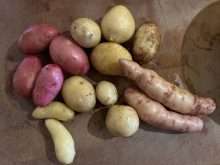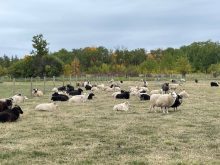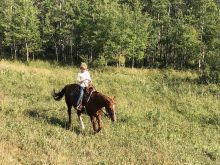Good food is always a trouble and its preparation should be regarded as a labour of love,” says famed English food writer Elizabeth David in French Country Cooking, first published in 1951.
And, as U.S. chef Paul Bertolli writes in his 2003 book, Cooking by Hand, referring to David: “The trouble with cooking begins when you decide to take it seriously.”
He goes on to chronicle learning in Italy that “simplicity represents the trouble that many generations of cooks have taken to arrive at the best expression of their native ingredients… Experience has shown that the trouble you take will also be your enduring pleasure.”
Read Also

Gentle treatments for pain in the neck
Heading toward year-end, people unknowingly tense up against the cold and busyness, causing neck pain that can often be treated with appropriate support and gentle mobility, athletic therapist Kathlyn Hossack says.
I envy cooks who grow up in a well-defined culinary tradition, in a culture that has existed for centuries. They grow up knowing their home, their land, the ingredients and dishes that arose from that place. As a descendant of folk who immigrated to Canada in the late 1800s, as a new arrival in this place where my family has resided for a mere century, I do not feel an inborn culinary connection to the land we now shepherd and safeguard. It’s my loss as a cook and diner. It’s our loss as a nation of immigrants to not have a defined national or regional cuisine. I myself am a peasant, of assorted peasant stock, crossbred from Hutterite farmers and artisans — who began in deep valleys and high mountains in Austria and ended up in Ukraine before departing for America — and Irish and Scots weavers and smiths. As a cook, I have a foot in those camps but no traditions going back to nonnas and poppas of previous centuries and generations.
It’s a challenge to weave a personal culinary tapestry from such disparate origins. For years I compensated by trying on the cuisines of other countries and other cultures, as most of us do — as I still do. What matters is that I acknowledge their origins, pay homage to their places of beginning, and thank the cooks from other places and traditions who came before me.
One of the truest ways to bear my gratitude forward is to honour my hands and hone my skills. To be the best cook I can be. To be honest and methodical in making the most of what skills the Good Mother put into my hands. To cook from scratch, with real and vital ingredients, whenever I can.
So… my hands. They are a tool for good, and for goodness. I hand-shape sourdough bread, roll pasta, chop vegetables, fill dumplings, bone poultry and grow herbs and vegetables. My hands knead and stretch and shape, fold and pleat. They evaluate texture and assess degree of doneness. My hands are my first tools. I extend their reach and capabilities with tools: knives and offset spatulas, olivewood spoons and spurtles, mortars and pestles.
Without getting overly mystical about it, I believe in the connection forged when cooking by hand. Bread and pasta seem undeniably better when I’ve had my hands on the dough, but not to the senseless exclusion of machinery and tools: I’ve baked cookies that are best when whizzed up by machine. So what I mean is the synergy and energy created and magnified in cooking, period — cooking from scratch, handmade cooking, as opposed to feeding people by opening cans or ready-made meals. Cooking has strength and power and beauty in it, and my hands are the manifestation of that action. So first we eat, then we talk about our favourite homemade meals.

Twice-cooked smoked brisket sammies
Last summer, to celebrate several family birthdays, I overfilled my smoker with racks of ribs, chicken thighs and a honking big brisket. The pork and poultry were splendid, but I undercooked the brisket, which went mostly untouched at our family’s birthday table. I froze it, and this winter I pulled it from the freezer and braised it for several hours in beef stock and red wine with carrots and onions. Then I had something stellar to work with — succulent slices in rich broth — and many options. Should I make a pot pie? Pasta? Risotto? Those yummy grilled pork or satay beef Vietnamese sandwiches, banh mi? Yes. Those, in memory of my dad, Paul Smith, and his abiding love for hot beef sandwiches. Serves 4.
Pickled vegetables:
- 1 finely sliced long English cucumber
- 1 large carrot, julienned
- 1 small daikon, julienned, optional (use finely sliced radishes instead)
- 1 c. rice wine vinegar
- 1 Tbsp. fish sauce
- ½ c. cold water
- 2-3 Tbsp. sugar A pinch of hot chili flakes
The rest:
- Grilled or roasted/braised chicken, pork or beef, sliced
- 4 crusty rolls or 6-inch baguette slices, split lengthwise
- Mayo
- Hot pickled peppers
- chopped peanuts for garnish
- cilantro sprigs for garnish
Combine all ingredients for the pickled vegetables. Let them stand while you gather the rest of the ingredients.
To assemble the sandwiches, cook or reheat the meat, then layer it with pickled vegetables into the rolls or baguettes. Top to taste with mayo, peppers, peanuts and cilantro. Serve immediately.















